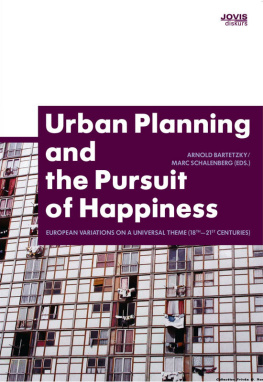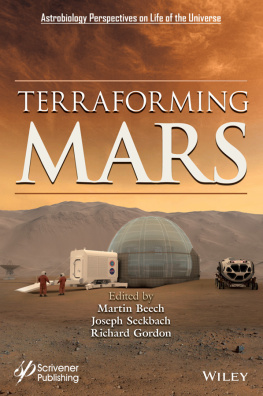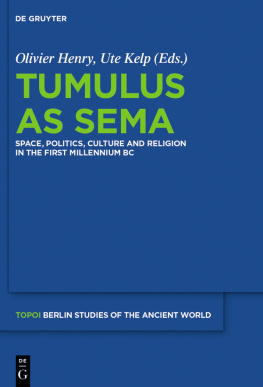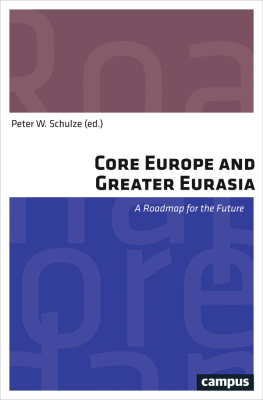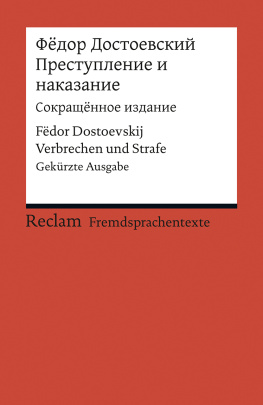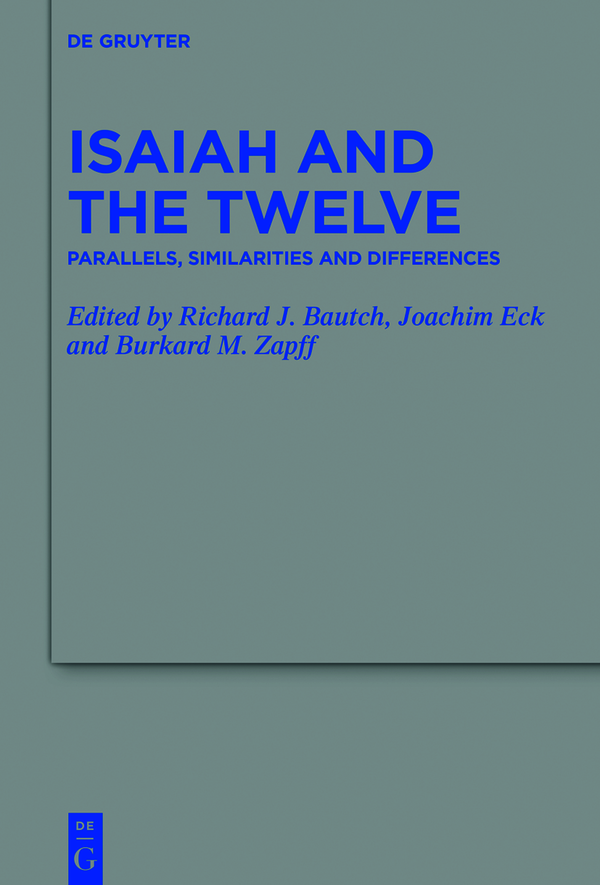Beihefte zur Zeitschrift fr die alttestamentliche Wissenschaft
Edited by
John Barton
Reinhard G. Kratz
Nathan MacDonald
Sara Milstein
Carol A. Newsom
Markus Witte
Volume
ISBN 9783110705737
e-ISBN (PDF) 9783110705799
e-ISBN (EPUB) 9783110705881
Bibliographic information published by the Deutsche Nationalbibliothek
The Deutsche Nationalbibliothek lists this publication in the Deutsche Nationalbibliografie; detailed bibliographic data are available on the Internet at http://dnb.dnb.de.
2020 Walter de Gruyter GmbH, Berlin/Boston
Introduction
Theological research has repeatedly noted similarities and intersections between the book of the prophet Isaiah and specific passages of Scripture within the Book of the Twelve (the Twelve Minor Prophets), or the Book as a whole. The various attempts to explain these parallels culminated - for the time being - in the suggestion by Odil-Hannes Steck and his student Erich Bosshard-Nepustil that interrelated theological circles carried out one or multiple revisions to Isaiah and the Book of the Twelve, or to particular parts of the same, with the aim of making these corpora more closely analogous in their structure and content. From 31 May to 3 June 2018 and sponsored by the Deutsche Forschungsgemeinschaft (DFG), an international conference held at the Catholic University of Eichsttt-Ingolstadt considered, first, whether particular writings within the Book of the Twelve, or the complete corpus, do indeed share features with Isaiah or parts of it, and second, if this is the case, how we might describe and seek to explain these commonalities. A previous event, held in November 2016 at St. Edwards University (the Catholic University in Austin, Texas), had explored Voices of Israel - Isaiah and Micah: Intersections in Judean Prophecy during the Eighth Century BCE in the context of the relationship between Isaiah and Micah. The conference in Eichsttt sought to expand this specific focus to include the entire Book of the Twelve. Its organisers, in bringing together eminent experts on these Biblical writings from Germany and around the world, hoped to initiate methodological dialogue, countering the tendency occasionally witnessed among Old Testament scholars to talk about one another rather than to one another and providing optimum conditions for illuminating the process of growth and theological depth of the scriptures under study.
Exegesis should not be an end unto itself, but should rather serve to inspire and vivify the way the Church views itself and the life it leads. That life energizes the practice of exegesis and raises new questions to explore, opening up paths to a fresh understanding of Biblical texts. This tenet shines forth clearly in this volumes concluding essay by His Excellency Bishop Rudolph Voderholzer, a specialist in Biblical hermeneutics whose work takes a systematic approach to the subject. Since his Festvortrag reflects upon and responds to our exegetical work during our time together, he receives the last word in this volume. We are profoundly grateful to him for having taken the time out of his demanding schedule as a diocesan bishop to attend our conference and help build a bridge between exegesis and systematic theology.
In this volume, the chapters progress in line with the two central questions outlined above. In parts one and two, the authors examine the interrelationships between Isaiah and specific writings from the Book of the Twelve. The order of these chapters is chronological, beginning with writings attributed to prophets of the eighth century BCE and their connections to Isaiah, particularly its opening part, and proceeding to texts - or groups of texts - from both corpora which probably date from the period of the exile or thereafter. Along with identifying and seeking to validate similarities and parallels between the various writings, the chapters examine the history of their redaction and revision. After establishing whether a relationship of any kind exists, our authors aim to find potential explanations for their findings, an endeavour in which they apply a range of recent insights on the hermeneutics of the Prophets.
In the volumes opening chapter, Franz Sedlmeier takes on the relatively neglected issue of the relationship between Isaiah and the book of Hosea. His findings present a nuanced picture. The indications are that the historical figure of Hosea is unlikely to relate directly to that of Isaiah. Further, the occasionally occurring common themes and the conspicuous parallels between the headings found in Isaiah and in Hosea in terms of the chronology of the prophets public activity appear to be attributable to later revisions, at least some of which require interpretation in the context of Hoseas incorporation into the Book of the Twelve.
Uwe Becker, the author of chapter two, examines the prophecies about social justice found in the book of Amos as potential sources for the passages in Isaiah that herald social justice. Becker demonstrates that Isaiahs castigation of injustices is not an authentic part of his prophecy, but rather was drawn from both the original text of Amos and from secondary additions. His chapter points to the process of alignment or approximation that took place between various prophetic books of the Bible and their key messages.
James Nogalski, analysing the final verses of Zephaniah, lays bare the numerous parallels they contain to the content and language of Isaiah and suggests that they might point to commonalities in the circles of their authorship. Conversely, contrasts in the parallels highlight the substantial differences in the depiction of Zion in evidence in the two writings.
The chapter by Burkard M. Zapff on the relationship between the Book of the Twelve and what is known as Deutero-Isaiah asserts that the Book as a whole both pays virtually no attention to themes at the heart of Deutero-Isaiah and places quotations from it in a new context requiring an altered theological and political setting. In Zapffs view, any distinct intersections between themes in the Book of the Twelve and those in what is termed Trito-Isaiah might point to the revisions to the Book which aligned it more closely with Isaiah in the post-exilic period.
The contribution by Richard Bautch centres on the much-discussed, highly intertextual passage Zechariah 11 with its multiplicity of intertextual references, particularly to Isaiah 10:33-34. Bautch succeeds in demonstrating that Isaiah 10:33-34, one of the central passages on which the text draws, creates new possibilities for interpreting Zechariah 11 by effectively serving as a form of bridge for its opening and closing oracles.
The similarities remarked upon repeatedly in more recent research on the Twelve Minor Prophets between the concluding chapter of Zechariah and Isaiahs final section is the subject of Todd Hibbards essay. The assumption hitherto has been that theologically aligned groups of authors worked on these writings. Hibbards examination of the texts, by contrast, uncovers within the texts a distinctly different treatment and development of similar theological interests and motifs. Following Hibbards analysis, there is no straightforward answer to the question of whether later writings of Isaiah had a direct influence on Zechariah 14; topical resemblances between the two texts stand against a striking contrast in these themes specific treatment.
A different conclusion emerges from Christopher Hays analysis of the relationship between Zephaniah and Isaiah 24-27, often termed the Isaiah Apocalypse, which reveals close interconnections in both language and content. While the conclusions Hays draws from his findings may surprise some, the rationale he presents has a high degree of plausibility: The broad consensus dating a substantial core of Zephaniah to the seventh century BCE justifies, in Hays view, the attribution of an equivalent date to the rather misleadingly named Isaiah Apocalypse, notwithstanding its frequent interpretation as a later text. A further assertion Hays bases on his findings is that those responsible for penning Zephaniahs original version also created the substance of Isaiah 24-27.



